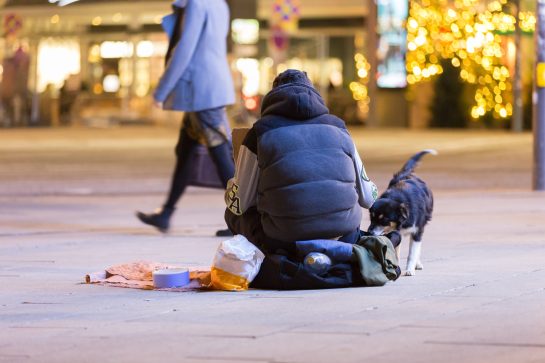There’s no place like home for the holidays—but what if you don’t have a home to go to? For over half a million individuals in the US, this is the reality they face every day. As winter temperatures drop, those experiencing homelessness are in need now more than ever for help from our communities.
Homelessness and Poverty Facts
As of 2021, approximately 552,830 people are experiencing homelessness in the United States. About 70% of these people are individuals, meaning that almost a third of all unhoused people are families. Despite this fact, the majority of shelters are single-gender, meaning that families must often separate if they want to take advantage of housing services.
New York and California have the highest rates of unhoused individuals, with 46.9 and 40.9 people per 10,000 experiencing homelessness, respectively. Even still, there are people experiencing homelessness in each and every state across the US. Although white individuals make up the largest number of unhoused people, proportionally Hawaiians and Pacific Islanders have the highest rate of homelessness (109 out of every 100,000).
Homelessness and Social Determinants of Health
Race isn’t the only factor contributing to rates of homelessness. Many key social determinants of health–including poverty, access to healthcare, education, and food security–play an important role in the risk of homelessness.
These cross-cutting concerns highlight just how important care coordination is for unhoused individuals. Homeless shelters, food banks, workforce development agencies, and domestic violence support systems all serve people experiencing homelessness. The better they can work together, the better they can support people without a roof over their head.
Case management systems like ClientTrack® are a critical service to help health and human service organizations coordinate together and amplify the help that unhoused individuals and families receive. Check out how one community is using ClientTrack to reduce homelessness through care coordination here.
Effects of Homelessness on Health
While homelessness is a public health crisis every day of the year, there are additional concerns that come into play during the holiday months. As December comes around, dropping temperatures can spell disaster for unhoused individuals. In fact, every year approximately 700 Americans die from hypothermia relating to lack of shelter. With COVID-19 continuing to cause issues with shelters, this number is likely to be higher this holiday season.
Unfortunately, many emergency shelters do not open until temperatures are well below freezing, leaving those experiencing homelessness exposed to deadly conditions. Supplies are stretched thin, with warm blankets, socks, and coats going quickly.
It’s hard not to feel discouraged when faced with these facts. There is a silver lining, however; helping alleviate the issues of homelessness in the US is a lot easier than many think. What’s more, both individuals, families, and communities can make a big difference for those experiencing homelessness in their local areas. Check out below for tips on how individuals, families, and organizations can all get involved this holiday season to help out their community members experiencing homelessness.
What You Can Do
So, what exactly can you do to help out those experiencing homeless during the holidays? Get started with our list of suggestions below. Don’t forget to drop a comment if there’s something we forgot!
- Volunteer at a Homeless Shelter
Do you know where your local homeless shelter is? If not, there’s no time like the present to find out! These organizations are often the most tapped into the needs of the unhoused in your community. If you’re not sure where to find one close to you, check out this shelter finder from the HUD website. - Talk to your Kids About Homelessness
Kids are keen observers, and we can learn a lot from their open mindedness. Stopping the stigma surrounding those experiencing homelessness begins at home. Talk to your kids about the statistics of homelessness and the factors that contribute to it (you can refer to the sections above as a good place to start). - Donate to Your Local Food Bank
As you enjoy meals and quality time with those you love, think about what it would be like not to have that privilege. Donate non-perishable food to your nearby food banks, or stop by to see what help they need. If you’re really feeling the holiday spirit, you might even consider running a food drive in your neighborhood, school, or community group. - Reach Out to Those Experiencing Homelessness
Experiencing homelessness has a myriad of difficulties, but one of the hardest may be the loss of dignity that unhoused individuals experience. Remember that they are people just like you. Invite them to a church event, community light show, or even to grab a warm bite to eat. - Educate Yourself
There are still many stigmas surrounding the unhoused. Do your best to learn about the problems that those experiencing homelessness face, and share what you learn with your networks. A simple social media post can go a long way! - Advocate for the Unhoused in Your Community
Laws don’t change until people change. Advocate for those experiencing homelessness at your local, state, and national level. You can write your congressperson to increase funding for shelter, increased resources for the unhoused, and leniency with encampments. - Express Gratitude
More than anything, be sure to take a moment and be grateful for the experiences you have and the chance to help out others experiencing homelessness. The holidays are a great chance to both reflect on and spread around a little more gratitude.



